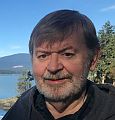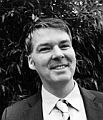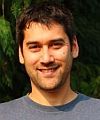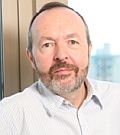ASSET MANAGEMENT BC NEWSLETTER (January 2011):”Actions and targets in Living Water Smart encourage ‘green choices’ that will foster a holistic approach to infrastructure asset management. Protection of a community’s natural resources is emerging as an important piece in Sustainable Service Delivery,” foreshadowed Glen Brown

Glen Brown is the visionary and thought leader who coined the term “sustainable service delivery”. This way of viewing the local government sphere of responsibility changes everything about how local governments do business in an era of rapid change. “Level-of-Service is the integrator for everything that local governments do. What level of service does a community wish to provide, and what level can it afford? Everyone will have to make level-of-service choices. Establish the level-of-service that is sustainable to protect watershed health,” stated Glen Brown.
ASSET MANAGEMENT FOR SUSTAINABLE DRAINAGE SERVICE DELIVERY: “In the big picture, the last two decades have been characterized by an inability to act on the science. The consequence is a growing Riparian Deficit,” wrote Kim Stephens in an article published in the Asset Management BC Newsletter (October 2022)

“In the 1990s, seminal research at the University of Washington on the science of land use changes produced a road map for protection of stream system integrity. For the past generation of practice, then, communities and practitioners should have known what they ought to be doing. And some have made progress. Land use realities – master drainage planning, integrated stormwater planning, development pressures, etc. – push local government to pay lip-service to the role of the streamside protection zone,” stated Kim Stephens.
ASSET MANAGEMENT FOR SUSTAINABLE DRAINAGE SERVICE DELIVERY: “Township staff are working on a long-term Ecological Services Initiative program. The Ecological Accounting Process analysis will be used to establish the baseline funding for payment to farmers,” stated Melisa Gunn, Agricultural Planner with the Township of Langley

“To move the Ecological Services Initiative project forward, the Township of Langley was looking for a process that used real numbers to understand how to develop fair and equitable payments to farmers to enhance areas on their properties. Through the EAP work, the concept of ‘Riparian Deficit’ in the natural commons area highlights the shared responsibility of rural and urban landowners to maintain Bertrand Creek, an important asset in the Township. In the future, we can use EAP to expand the program to other watersheds,” stated Melisa Gunn.
ASSET MANAGEMENT FOR SUSTAINABLE DRAINAGE SERVICE DELIVERY: “Nature appears more fragmented because we have to slice it into categories and dice those categories into bits before we can value bits of those bits,” stated John Henneberry (1952-2021) Professor of Property Development Studies, University of Sheffield, United Kingdom

John Henneberry’s pioneering work serves as validation of how EAP, the Ecological Accounting Process, looks at streams and water assets as a system. His eclecticism produced real insights into the operation of land and property markets, enabling all involved to see things more clearly and differently. “An industry has developed that values different aspects of nature in different ways. The sum of these parts is far short of the whole and does not capture the interconnectedness and holism of nature,” stated John Henneberry.
ASSET MANAGEMENT FOR SUSTAINABLE DRAINAGE SERVICE DELIVERY: “The BC Framework points the way to integration of natural systems and climate change thinking into asset management,” stated stated Liam Edwards, a former Executive Director with BC Ministry of Municipal Affairs, in 2015

‘Asset Management for Sustainable Service Delivery: A BC Framework’ makes the link between local government services, the infrastructure that supports the delivery of those services, and watershed health. The BC Framework provides context for EAP, the Ecological Accounting Process. “By accounting for and integrating the services that nature provides, communities can achieve the goal of Sustainable Service Delivery for watershed systems. Resilient cities will be the ones that can absorb water and manage the water cycle as a closed loop,” stated Liam Edwards
DOWNLOAD BEYOND THE GUIDEBOOK 2022: “Because local governments need real numbers to deliver outcomes, we landed on a concept which we call the Riparian Deficit. This is a measure of land use intrusion into the streamside protection zone,” stated Tim Pringle, Chair of the Ecological Accounting Process (released June 2022)

“Now that we have landed on the Riparian Deficit concept, we are able to reflect on the two issues which provided context for the journey: first, engineering measures are insufficient for stream and riparian protection; and secondly, the link to municipal asset management has not been clear. To reach the destination, we had to address and show how to overcome four challenges: one, a lack of measurable metrics; two, confusion over what is an asset versus a service; three, ignorance about how to quantify the financial value of natural assets with real numbers; and four, numerous one-off projects that fail to build improved asset management practice,” stated Tim Pringle.
DOWNLOAD BEYOND THE GUIDEBOOK 2022: “Ecological Accounting Process, a BC Strategy for Community Investment in Stream Systems” (released June 2022)

“If we know how to do a much better job of protecting ecological features and stream systems in our communities and on our landscape, then why aren’t we doing a better job? Why are streams still degrading? Why do we still see practices that exacerbate the situation? Why is understanding lacking? How do we change that? An elephant in the room is the hollowing out of government capacity at all levels and the reliance on outside service providers. A lack of understanding of the science of stream system integrity and that a stream is a system, is widespread,” stated Kim Stephens.
BEYOND THE GUIDEBOOK 2022 / EXECUTIVE SUMMARY: If we know how to do a much better job of protecting ecological features and stream systems in our communities and on our landscape, then why aren’t we doing a better job? Why are streams still degrading?

The process is in motion to operationalize a transition strategy over a 3-year period and initially embed the Ecological Accounting Process (EAP) program in the Mount Arrowsmith Biosphere Region Research Institute (MABRRI). “We believe that incorporating students from Vancouver Island University and other universities will support understanding and experience within municipal governments on the importance of EAP, and simply understanding EAP. Fortunately, most of VIU’s Master of Community Planning, and Master GIS students find themselves working within municipal governments,” stated Graham Sakaki.
BEYOND THE GUIDEBOOK 2022 / PART A: “John Henneberry’s pioneering work in the United Kingdom serves as validation of how EAP looks at streams and water assets as a system,” stated Tim Pringle, Chair of the Ecological Accounting Process initiative, a BC strategy for community investment in stream systems

John Henneberry was a source of inspiration to Tim Pringle during the early years of the Ecological Accounting Process program. John’s pioneering work in the United Kingdom validated the whole-system philosophy that guides use of EAP. His interests lay at the interface between planning and property; and focused on the use of economic instruments in planning and reproduction of the urban built environment. “Our view of nature is biased to those aspects of it that can be measured and particularly to those that can be valued,” stated John Henneberry.
BEYOND THE GUIDEBOOK 2022 / PART B: “We eventually concluded that operationalizing asset management would involve four separate, interconnected initiatives that would be the pathway for our journey toward Sustainable Service Delivery. They coalesced into what we locally refer to as The 4C’s – Collaboration, Capacity, Culture, and Council,” stated David Allen, retired Chief Administrative Officer, City of Courtenay

Sustainable service delivery is how communities can bridge the gap, or disconnect, between short-term and long-term thinking. Sustainable service delivery occurs alongside associated evolution in community thinking. Incremental in nature, it is a continuous quality-improvement process. “It is all about building trust between Council and staff, keeping in mind what can realistically be accomplished by an organization, and being clear about the limitations of the current state-of-practice and knowledge and our ability to explain what the numbers mean in that context,” stated David Allen.

